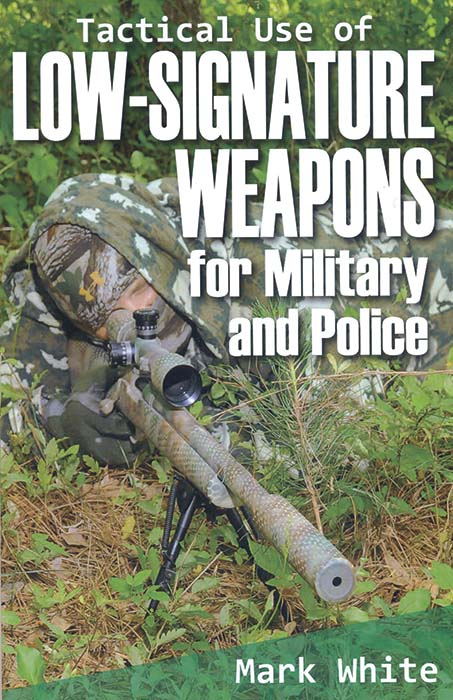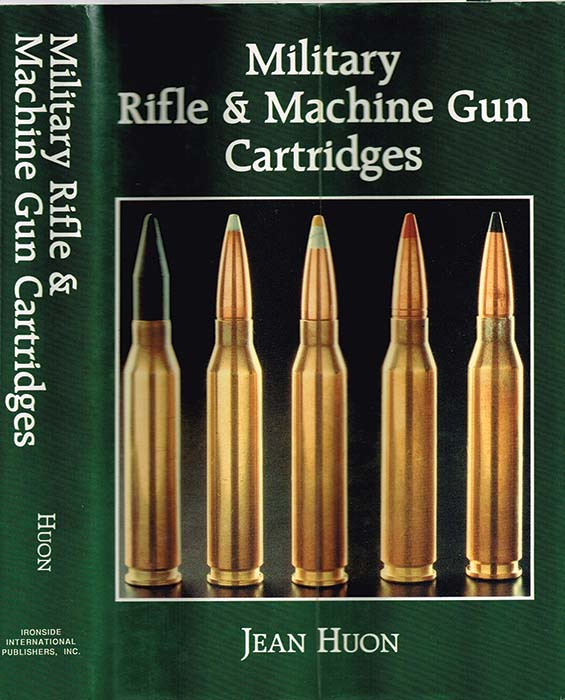By Dean Roxby

Tactical Use of Low-Signature Weapons for Military and Police
By Mark White.
Copyright 2010, 2012 Paladin Press.
Soft cover, 5 ½” x 8 ½” 110 pages $15.95
Reviewed by Dean V. Roxby
Suppressed firearms hold a particular fascination for many shooters. This book explores the science and myths associated with suppressors. The book is divided into many short individual chapters covering such topics as: The True Cause of Firearm Discharge Noise- The Mach Disc, Bore Diameter and Relative Loudness, Power Levels of Subsonic Ammo, etc.
While the book does contain much useful information, it also tends to wander somewhat. Six pages dedicated to ancient spears and arrows seem a bit out of place. (Although, to be fair, there is a brief reference to the lethal range of 4,000 year old sling technology in a critical look at the 5.56×45 round later on.) As well, many of the chapters are no more than one or two paragraphs long, yet are given a full page. The result is that rather than 110 pages of info, there are perhaps 60 or 70 pages of actual suppressor information. The book is primarily text, with no plans, design sketches, charts, or graphs given, and only a few photos.
Having said that, it is a good source of firearms info, with attention paid to such the above mentioned Mach Disc, the supersonic crack of a bullet, barrel porting to keep the bullet subsonic, energy levels of a subsonic bullet, even the issue of moisture trapped in the barrel if the suppressor is kept on the rifle. Much attention is given to the matter of longer, heavier bullets suited for subsonic use, and the appropriate rifling twist required. The subject of getting bullets to yaw or turn sideways after striking flesh is addressed as well, including a chapter on Slant-Nose bullets. The author also mentions that as a subsonic round does not require a long barrel to achieve great velocity, the barrel can be made shorter and therefore stiffer, thus giving greater accuracy. The four page chapter on powder selection and charges is quite informative.
The book ends with a chapter discussing the ballistics of various supersonic cartridges often used for police and military sniping work, followed by a warning about test firing a new suppressor with subsonic ammo prior to using supersonic ammo.
Overall, this book does contain some very good information relative to the author’s targeted subjects, but it is not the complete treatise on suppressor technology.

Military Rifle and Machine Gun Cartridges
By Jean Huon
Copyright 1988. Ironside International Inc., Alexandria, VA
Hardcover, 6” x 9” 378 pages.
$34.95
Reviewed by Dean Roxby
If you are a serious cartridge collector or student of military small arms, you should be aware of this book. Very well written, and very thorough, it details military rifle cartridges in use since 1870.
The author, Jean Huon, originally published this book in French, (Les Cartouches Pour Fusils Et Mitrailleuses). He is a very prolific author, having many articles (including over three dozen for SAR) and books to his credit. He is recognized as a very thorough researcher, so it is no surprise this book is first class reference material. It must be noted that it was printed in 1988, so there are several cartridges that came later that do not appear in this edition. (There is an updated version in French).
The book is divided into two main parts, Metric calibers and British & U.S. (meaning Imperial dimensions) cartridges. A short introduction precedes the main reference section. This introduction briefly describes the chronological progression of ammunition development, starting with paper cartridges, then rimfire and pinfire, and finally centerfire. The Metric section is the largest section of the two due mainly to the numerous European designs. Each cartridge is given at least a full page, sometimes more.
The 8×57 Mauser and the .30-06 are each given seven pages and the mighty .303 British is given eight pages. Most of this is used for photographs and notes of variations of the round like ball, tracer, AP, blank, wood blank, drill rounds, etc.
Besides the usual suspects, there are some really rare, unusual rounds profiled. Ever heard of or seen a .40 Booby Trap round? It is a British WW2 era anti-personnel “set-gun” device that is left in the ground, much like a mine.
As is traditional for cartridge books, the rounds are listed in order of increasing diameter, from 4.5mm (4.5×26 Interdynamic rimfire) to 18mm (18x35R Tabatiere), and .17 (.17 SBR) to .60 machine gun. Each entry gives cartridge dimensions and weight of a complete round. (Entirely in Metric! Be aware of this if you are Metric-challenged.) There is also a brief but concise explanation and history of each round, and a photograph of a standard ball round, and often of other types. A photo of the rifle or MG most often associated with the cartridge is also shown. The photos are entirely B&W. The main photo of the round is in true scale, which makes it useful for identifying mystery rounds. A nice feature of this book is that if a cartridge has several names, they too are listed. The 8×57 has 12 aliases.
Following the Imperial section is a short section on various experimental rounds that were made in very limited amounts and never saw service. This section is only a group photo of cartridges, with no further details provided.
This book is a worthy addition to the library of any serious cartridge collector or military arms enthusiast.
| This article first appeared in Small Arms Review V18N2 (April 2014) |










